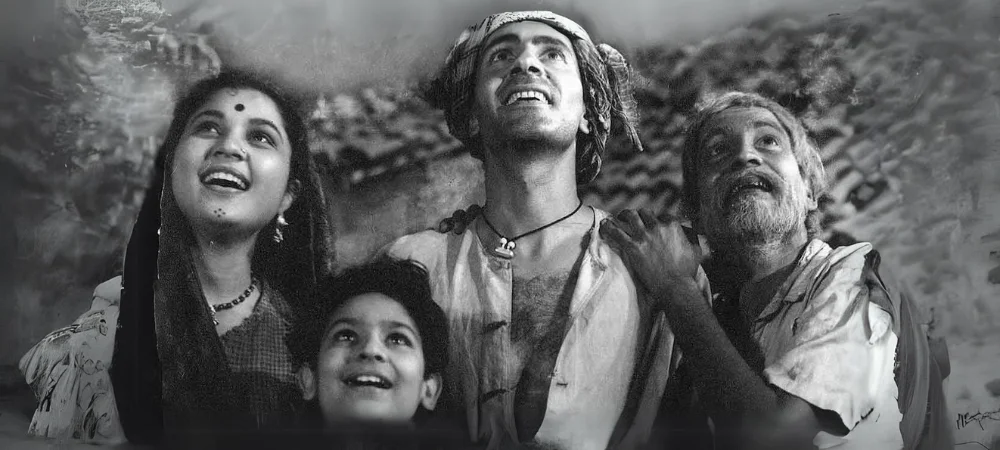“Do Bigha Zamin,” directed by Bimal Roy, is a landmark film in Indian cinema that was released in 1953. This movie is known for its powerful portrayal of rural poverty and human resilience. It stands out as a classic example of neorealism in Indian films.
Personalities:
Shambhu (Balraj Sahni): The protagonist, a poor farmer who struggles to save his small piece of land from being taken over by a greedy landlord. His determination and resilience drive the film’s narrative.
Parvati (Nirupa Roy): Shambhu’s loving and supportive wife. She endures the hardships of their poverty and stands by Shambhu through his struggles.
Kanhaiya (Rattan Kumar): Shambhu and Parvati’s young son. He follows his father to the city and tries to help in earning money to save their land. His bond with Shambhu adds emotional depth to the story.
The Landlord (Murad): The antagonist, a wealthy and ruthless man who plans to take over Shambhu’s land to build a factory. His actions set the conflict in motion.
Film Review:
The story centers around Shambhu, a poor farmer played by Balraj Sahni, and his struggle to save his small piece of land from being taken over by a greedy landlord. Shambhu’s land is his entire world; it is where he and his family live, and it provides them with their livelihood. The movie opens with a beautiful depiction of village life, highlighting the simplicity and hardships faced by the rural population.
The plot takes a grim turn when the landlord decides to take over Shambhu’s land to build a factory. Despite the court ruling in the landlord’s favor, Shambhu is determined to save his land. He is given three months to repay his debts to keep his land. This deadline sets the stage for Shambhu’s arduous journey to Kolkata to earn the required money.
In Kolkata, Shambhu faces numerous challenges. The bustling city is a stark contrast to his peaceful village. He takes up various odd jobs, including becoming a rickshaw puller. The scenes depicting Shambhu’s struggle in the city are heart-wrenching and highlight the harsh realities of urban poverty. Balraj Sahni’s performance is exceptional, capturing the desperation and determination of his character.
Shambhu’s son, Kanhaiya, follows him to the city in a bid to help his father. The bond between father and son is touching and adds an emotional depth to the story. They both work tirelessly, facing exploitation and harsh conditions, yet their spirit remains unbroken.
The film also sheds light on the stark divide between the rich and the poor. While Shambhu toils day and night to save his land, the landlord remains indifferent to the plight of the poor farmers. This contrast is effectively portrayed through the film’s narrative and visual style.
One of the film’s most poignant moments is when Shambhu, after immense toil, manages to gather a significant amount of money, only to find out that it is still not enough. His dream of saving his land seems impossible, and the despair in his eyes is deeply moving. This scene encapsulates the central theme of the movie – the relentless struggle of the poor against an oppressive system.
The cinematography by Kamal Bose is noteworthy. The use of black and white film enhances the realism and the bleakness of Shambhu’s plight. The city of Kolkata is depicted in all its chaos and vibrancy, contrasting sharply with the serene and simple life of the village.
The film’s music, composed by Salil Chowdhury, complements the narrative beautifully. Songs like “Dharti Kahe Pukar Ke” are soul-stirring and reflect the emotional core of the film.
“Do Bigha Zamin” is not just a film about one man’s struggle; it is a commentary on the socio-economic conditions of the time. It addresses issues like rural indebtedness, urban migration, and the exploitation of the working class. The film’s social relevance and its empathetic portrayal of human suffering make it a timeless classic. Bimal Roy’s direction is masterful, weaving a story that is both compelling and socially relevant.
The performances, especially by Balraj Sahni, bring an authenticity that makes the film resonate with the audience. The supporting cast, including Nirupa Roy as Shambhu’s wife Parvati and the young actor who plays Kanhaiya, add depth to the narrative.
Conclusion:
“Do Bigha Zamin” is a powerful and moving film that stands the test of time. Its portrayal of the human spirit’s resilience against all odds is inspiring. The film remains a significant work in Indian cinema, reflecting the social issues of its time while delivering a universal message of hope and perseverance. Whether you are a fan of classic cinema or interested in stories that depict human struggles, “Do Bigha Zamin” is a must-watch.
The Setting:
The setting of Do Bigha Zamin is split between the rural village and the bustling city of Kolkata in the 1950s. The village represents simplicity and the agrarian lifestyle of Shambhu and his family, who rely on their small plot of land for survival. This idyllic yet poverty-stricken rural life is contrasted sharply with the chaotic and harsh urban environment of Kolkata.
In the village, Shambhu’s world is one of fields, mud houses, and close-knit community bonds, overshadowed by the looming threat of losing their land. When Shambhu moves to Kolkata to earn money, the film depicts the city’s crowded streets, towering buildings, and relentless pace. The urban setting highlights the stark disparities between the rich and the poor, as Shambhu navigates through various menial jobs amidst exploitation and hardship.
The contrasting settings underscore the film’s themes of struggle, resilience, and the socio-economic divide between rural and urban life.





